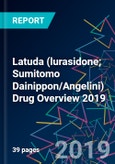Drug Overview
Latuda (lurasidone; Sumitomo Dainippon/Angelini) contains the atypical antipsychotic lurasidone, which acts as an antagonist of dopamine receptors D2, and serotonin receptors 5-HT2A. By inhibiting the synaptic reuptake of dopamine and serotonin, Latuda helps to normalize brain activity and reduce schizophrenia symptoms.
In 2011, Sumitomo Dainippon and Takeda entered into an agreement for the joint development and commercialization of Latuda in the EU (except for in the UK, where Sumitomo Dainippon retained exclusive rights), for the treatment of schizophrenia and bipolar disorder. Takeda terminated this alliance in May 2015, with all rights transferring back to Sumitomo Dainippon’s subsidiary Sunovion Pharmaceuticals. In November 2017, Sumitomo Dainippon announced a partnership with Angelini for the marketing and commercialization of Latuda in 29 European countries. While Sumitomo Dainippon will continue to supply Latuda in some EU countries including the UK, Angelini is now responsible for Latuda’s expansion to other countries. Latuda’s launch in Italy at the end of 2017 marked the first fruits of this strategic partnership.
Latuda has not yet been approved in Japan, but is in Phase III development for bipolar depression and schizophrenia. Sumitomo Dainippon plans to apply for manufacturing and marketing approval of Latuda in Japan in 2019. In the EU, Latuda is only approved for the treatment of schizophrenia.
Latuda (lurasidone; Sumitomo Dainippon/Angelini) contains the atypical antipsychotic lurasidone, which acts as an antagonist of dopamine receptors D2, and serotonin receptors 5-HT2A. By inhibiting the synaptic reuptake of dopamine and serotonin, Latuda helps to normalize brain activity and reduce schizophrenia symptoms.
In 2011, Sumitomo Dainippon and Takeda entered into an agreement for the joint development and commercialization of Latuda in the EU (except for in the UK, where Sumitomo Dainippon retained exclusive rights), for the treatment of schizophrenia and bipolar disorder. Takeda terminated this alliance in May 2015, with all rights transferring back to Sumitomo Dainippon’s subsidiary Sunovion Pharmaceuticals. In November 2017, Sumitomo Dainippon announced a partnership with Angelini for the marketing and commercialization of Latuda in 29 European countries. While Sumitomo Dainippon will continue to supply Latuda in some EU countries including the UK, Angelini is now responsible for Latuda’s expansion to other countries. Latuda’s launch in Italy at the end of 2017 marked the first fruits of this strategic partnership.
Latuda has not yet been approved in Japan, but is in Phase III development for bipolar depression and schizophrenia. Sumitomo Dainippon plans to apply for manufacturing and marketing approval of Latuda in Japan in 2019. In the EU, Latuda is only approved for the treatment of schizophrenia.
Table of Contents
OVERVIEW
LIST OF FIGURES
LIST OF TABLES








